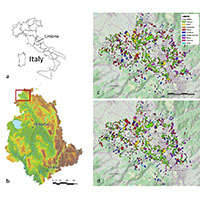Comparing Sentinel-1, Sentinel-2, and Landsat-8 data in the early recognition of irrigated areas in central Italy

Published: 23 December 2021
Abstract Views: 1246
PDF: 558
HTML: 59
HTML: 59
Publisher's note
All claims expressed in this article are solely those of the authors and do not necessarily represent those of their affiliated organizations, or those of the publisher, the editors and the reviewers. Any product that may be evaluated in this article or claim that may be made by its manufacturer is not guaranteed or endorsed by the publisher.
All claims expressed in this article are solely those of the authors and do not necessarily represent those of their affiliated organizations, or those of the publisher, the editors and the reviewers. Any product that may be evaluated in this article or claim that may be made by its manufacturer is not guaranteed or endorsed by the publisher.
Similar Articles
- Yane Ansanay, Praveen Kolar, Ratna Sharma-Shivappa, Jay Cheng, Sunkyu Park, Consuelo Arellano, Pre-treatment of biomasses using magnetised sulfonic acid catalysts , Journal of Agricultural Engineering: Vol. 48 No. 2 (2017)
- Federico Preti, Paolo Tarolli, Andrea Dani, Simone Calligaro, Massimo Prosdocimi, LiDAR derived high resolution topography: the next challenge for the analysis of terraces stability and vineyard soil erosion , Journal of Agricultural Engineering: Vol. 44 No. s2 (2013): Proceedings of the 10th Conference of the Italian Society of Agricultural Engineering
- Pasquale Dal Sasso, Maria Antonella Ottolino, GREENWAY IN ITALY: EXAMPLES OF PROJECTS AND IMPLEMENTATION , Journal of Agricultural Engineering: Vol. 42 No. 1 (2011)
- Paolo Balsari, Paolo Marucco, Claudio Bozzer, Mario Tamagnone, Study of a test methodology to assess potential drift generated by air-assisted sprayers , Journal of Agricultural Engineering: Vol. 44 No. s2 (2013): Proceedings of the 10th Conference of the Italian Society of Agricultural Engineering
- L. Pari, V. Civitarese, A. Del Giudice, A. Scarfone, Two prototypes for medium rotation forestry harvesting , Journal of Agricultural Engineering: Vol. 44 No. s2 (2013): Proceedings of the 10th Conference of the Italian Society of Agricultural Engineering
- Hyun Seok Song, Kyung Seok Sim, Tae Won Park, Optimal tread design for agricultural lug tires determined through failure analysis , Journal of Agricultural Engineering: Vol. 49 No. 1 (2018)
- Chiara Bassanelli, Gian Battista Bischetti, Enrico Antonio Chiaradia, Lorenzo Rossi, Chiara Vergani, The contribution of chestnut coppice forests on slope stability in abandoned territory: a case study , Journal of Agricultural Engineering: Vol. 44 No. s2 (2013): Proceedings of the 10th Conference of the Italian Society of Agricultural Engineering
- Enrico Fabrizio, Gabriele Garnero, The assessment of the visual perception in viewshed analysis for the landscape settings , Journal of Agricultural Engineering: Vol. 44 No. s2 (2013): Proceedings of the 10th Conference of the Italian Society of Agricultural Engineering
- Evelia Schettini, Giovanni Puglisi, Fabiana Convertino, Fernando Antonio Cancellara, Giuliano Vox, Greenhouse localized heating powered by a polygeneration system , Journal of Agricultural Engineering: Vol. 52 No. 3 (2021)
- Alex Otieno Owino, Najmun Nahar, Zakaria Hossain, Noma Tamaki, Effects of basalt fibres on strength and permeability of rice husk ash-treated expansive soils , Journal of Agricultural Engineering: Vol. 53 No. 1 (2022)
<< < 21 22 23 24 25 26 27 28 29 30 > >>
You may also start an advanced similarity search for this article.

 https://doi.org/10.4081/jae.2021.1265
https://doi.org/10.4081/jae.2021.1265







